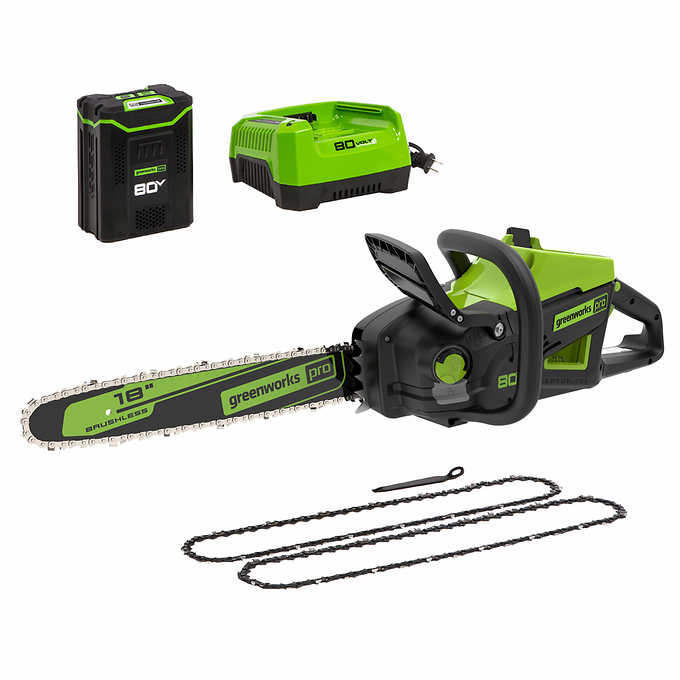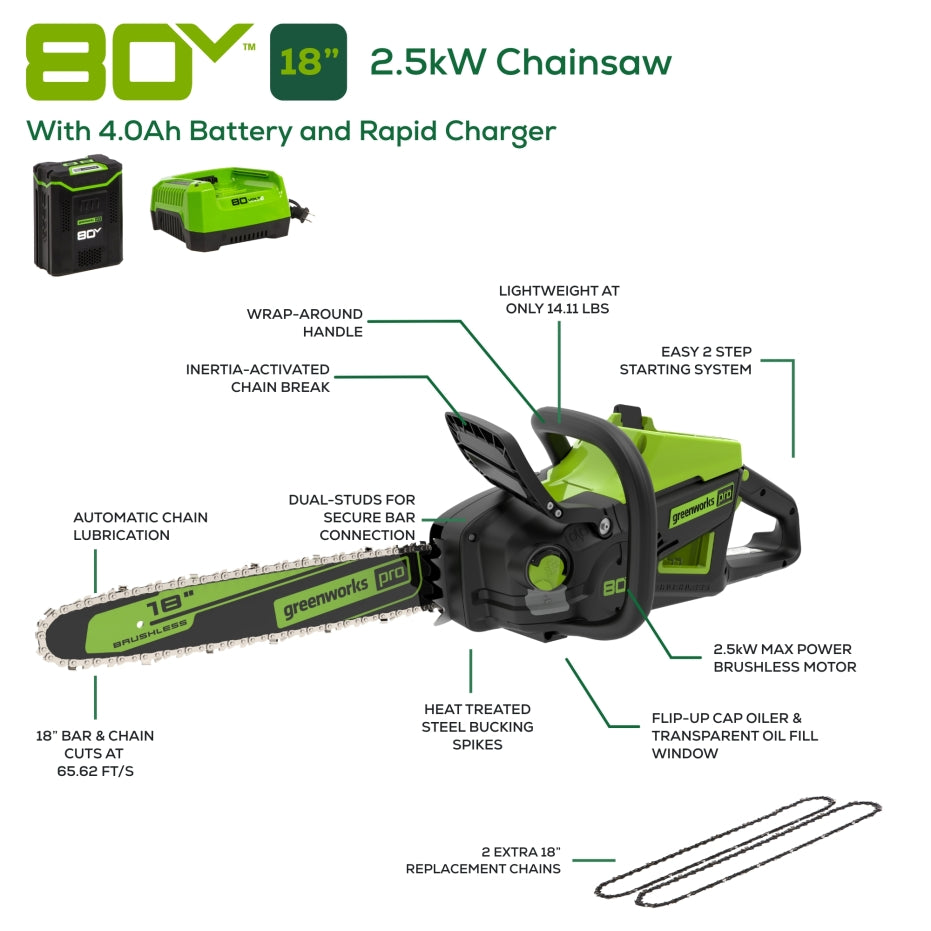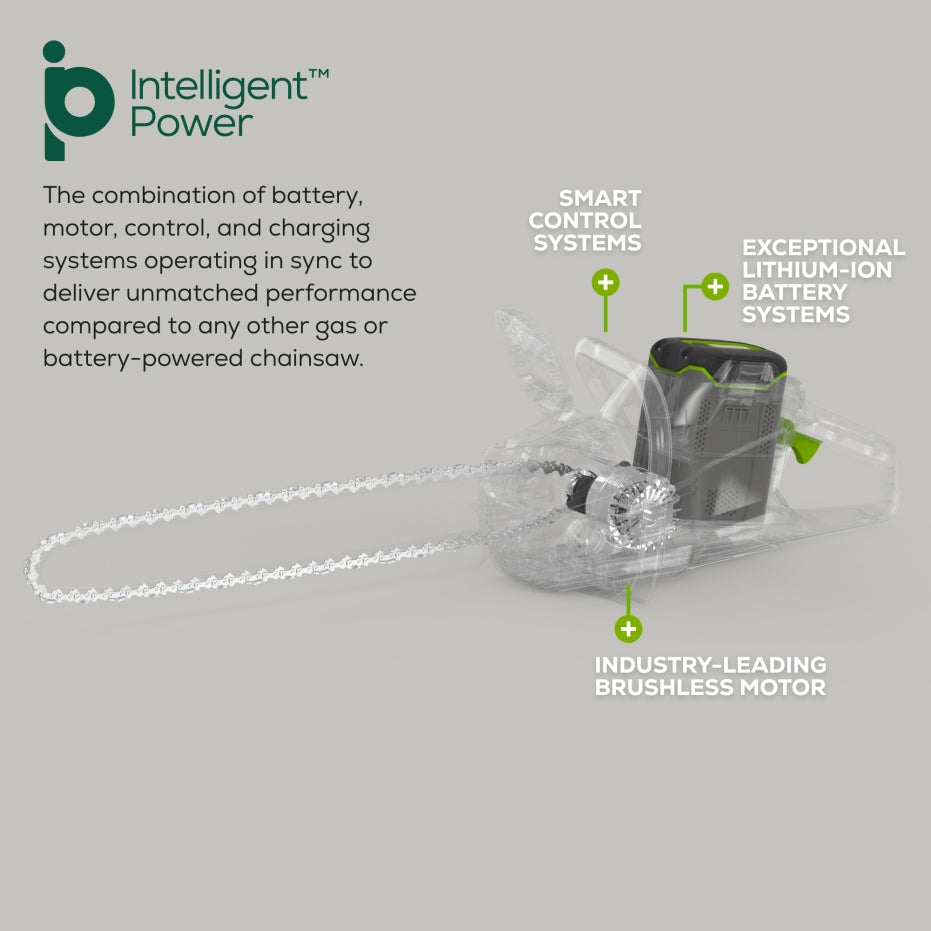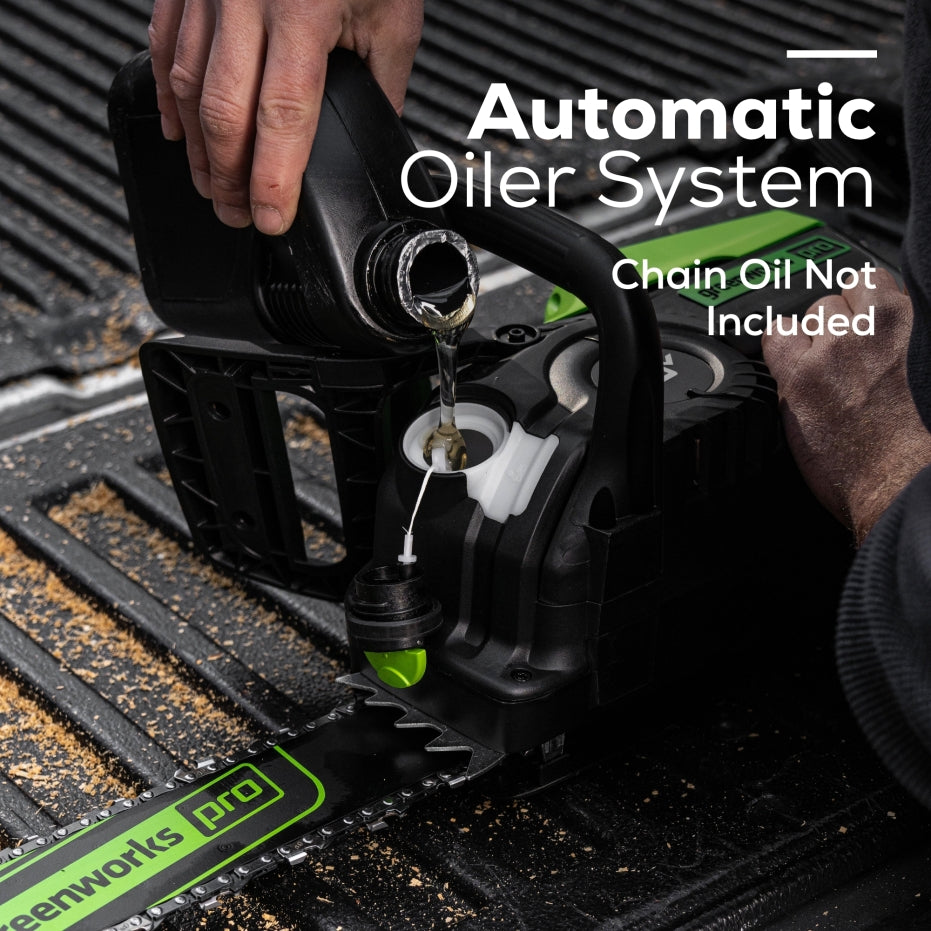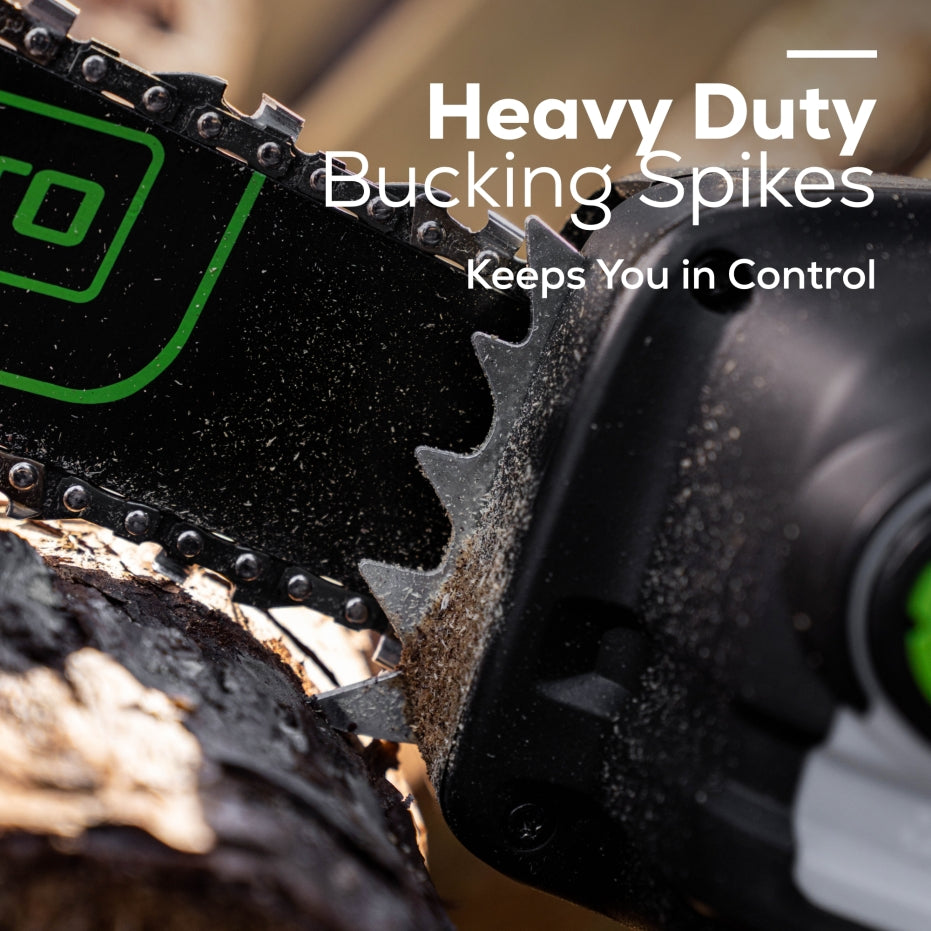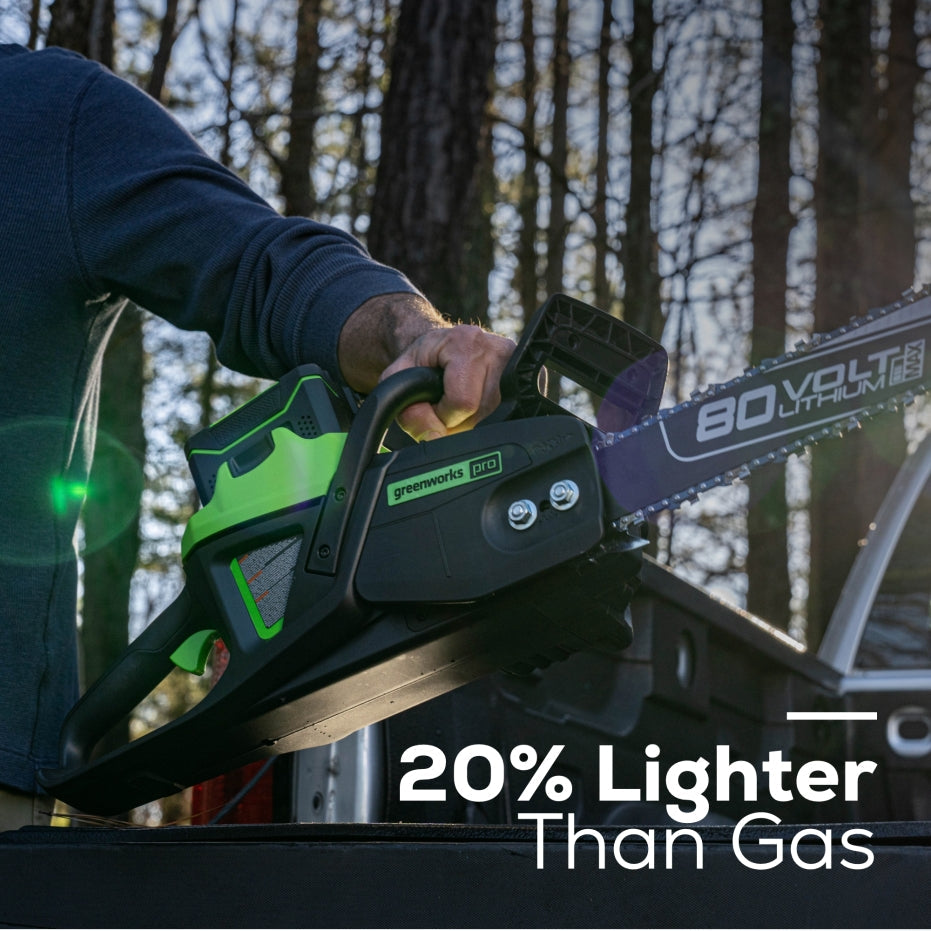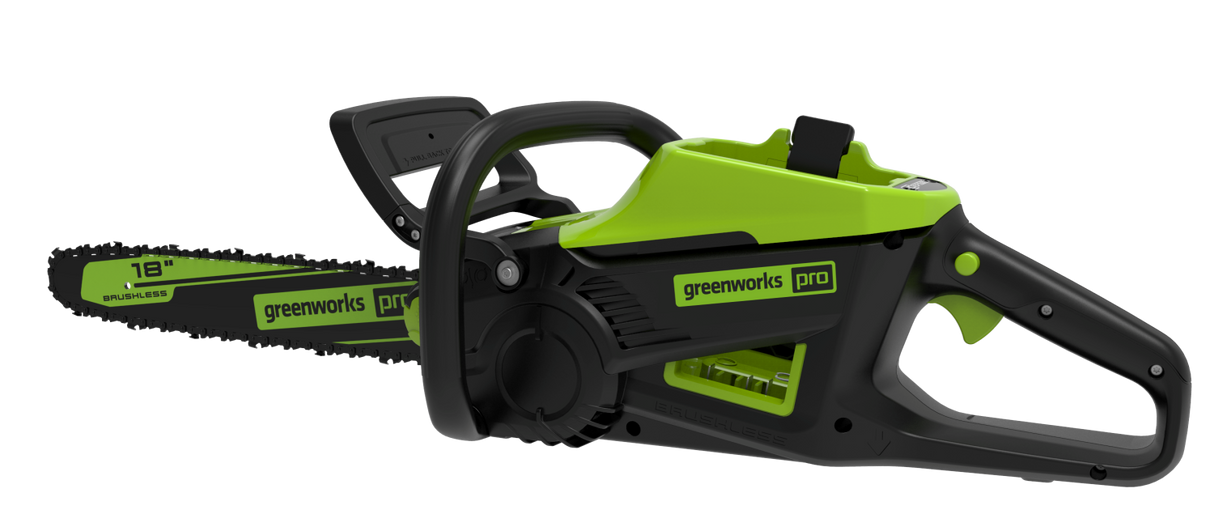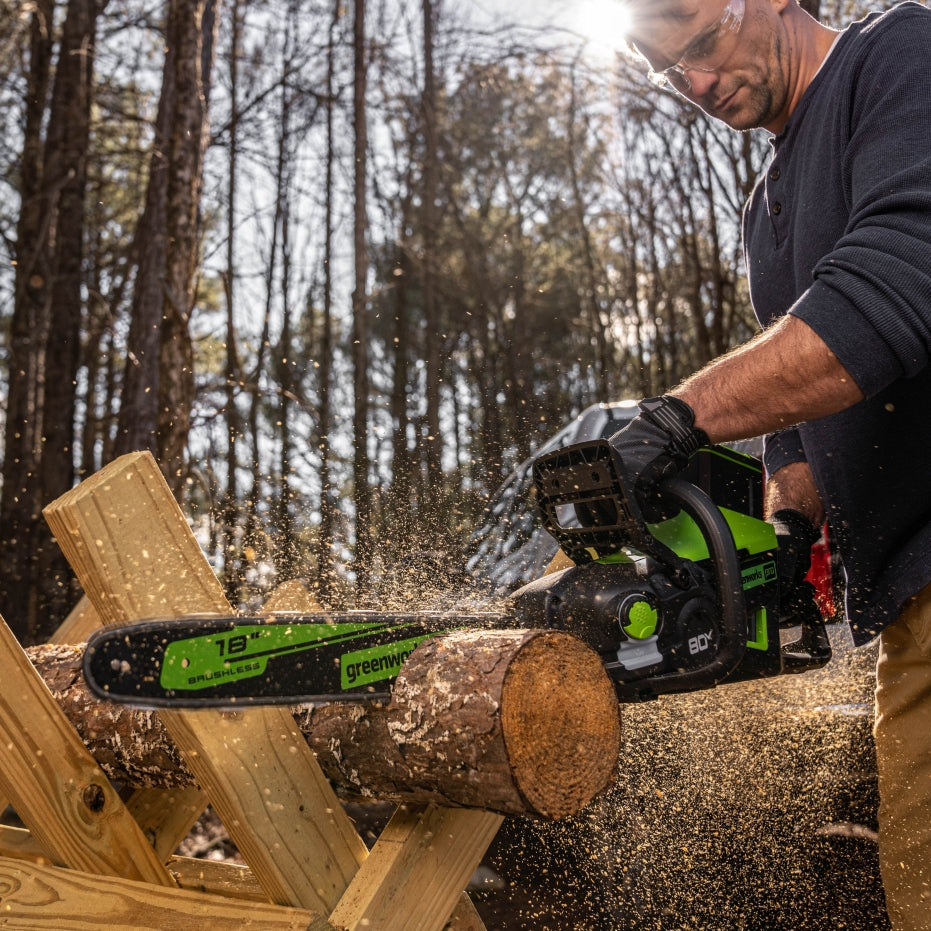Scie à chaîne 80 V, 18 pouces Gen II, batterie 4,0 Ah et chargeur rapide inclus
Principales caractéristiques
Principales caractéristiques
- ✓Moteur sans balais
- ✓Poignée enveloppante - Plusieurs positions de coupe lors de la coupe à différents angles.
- ✓Léger
- ✓Graisseur automatique - Assure la durabilité et prolonge la durée de vie de la chaîne.
- ✓Frein de chaîne mécanique
- ✓Pointes de trépan en acier
- ✓Poignée ergonomique pour une utilisation confortable
- ✓Garantie de 4 ans
Garantie
Garantie

Description
Description
Bienvenue à La Vie. Propulsée. par Greenworks. Découvrez la puissance et les performances des scies à chaîne thermiques sans le bruit, les fumées ni les émissions nocives. La scie à chaîne sans fil Greenworks Pro 80 V, alimentée par une batterie lithium-ion haute capacité, offre un couple 20 % supérieur et des vitesses de coupe plus rapides qu'un modèle thermique classique de 40 cm³, grâce à son moteur sans balais robuste. Notre système sans d'amorçage, d'étranglement ou de traction garantit des démarrages fiables et sans effort, sans cordon de traction, sans tracas. Conçue pour des performances professionnelles et une utilisation facile, cette scie à chaîne légère est équipée d'un guide-chaîne et d'une chaîne de 45 cm³, d'un tendeur de chaîne latéral de type professionnel pour des réglages rapides, d'un graisseur de chaîne automatique avec fenêtre transparente pour un entretien facile et d'un frein de chaîne pour plus de sécurité. La batterie Greenworks Pro 80 V alimente une gamme d'outils, vous offrant toute la polyvalence nécessaire pour réaliser vos projets extérieurs tout en éliminant les désordres et l'entretien liés à l'essence. Bénéficiant d'une garantie de 4 ans sur l'outil et la batterie, cette tronçonneuse est conçue pour durer, rendant le travail dans la cour plus simple, plus propre et plus écologique.
- 80 V Alimenté par une batterie lithium-ion avancée interchangeable de 80 V pour une puissance fiable et durable. Équipé d'une chaîne et d'un guide-chaîne robustes de 18 pouces de calibre 0,05 po pour des performances optimales.
- SANS BALAIS Moteur sans balais professionnel de 2,5 kW offrant un couple accru , un fonctionnement plus silencieux et une durée de vie prolongée. Avec une vitesse de chaîne allant jusqu'à 20 m/s, vous êtes prêt à relever les défis les plus exigeants. Son faible niveau sonore vous permet de travailler sans déranger vos voisins.
- PERFORMANCES : Réalisez jusqu'à 240 coupes sur une pièce de bois traité sous pression de 4 po x 4 po avec une seule charge de la batterie 80 V 4,0 Ah. Rechargez rapidement la batterie en 60 minutes maximum grâce au chargeur fourni.
- ERGONOMIQUE La poignée enveloppante pratique est conçue de manière ergonomique pour l'abattage et l'ébranchage. Légère, elle offre confort, contrôle, moins de fatigue et un risque de blessure réduit : 20 % plus légère que les modèles à essence comparables.
- SÉCURITÉ : Tendeur de chaîne latéral de type professionnel pour un entretien facile du guide-chaîne et de la chaîne. Équipé d'un frein de chaîne actif pour plus de sécurité et moins de risques de blessures.
- HUILEUR AUTOMATIQUE Le graisseur automatique applique de l'huile sur le guide-chaîne et la chaîne lorsque cela est nécessaire pour assurer la durabilité et une utilisation optimale avec un réservoir d'huile translucide pour une vue claire du niveau d'huile.
Spécifications
Spécifications
-
Longueur assemblée37,72 pouces
-
Largeur assemblée9,61 pouces
-
Hauteur assemblée10,43 pouces
-
Poids du produit (outil uniquement)9,5 lb
-
Dimensions du colis23,43 po. x 10,24 po. x 21,61 po.
-
Longueur du guide-chaîne18 po.
-
Pas de chaîne3/8 po. (0,375 po.)
-
Calibre de la chaîne1/2 po. (0,050 po.)
-
Liens d'entraînement62
-
Chaîne de remplacement91P062X/CL15062
-
Capacité d'huile de chaîne230 ml
-
Vitesse de la chaîneJusqu'à 66 pi/s
-
Frein de chaîne actifOui
-
GarantieGarantie de 4 ans
Manuels
Manuels
-
Télécharger :
Comprend
Comprend
- Scie à chaîne sans balais 80 V
- Fourreau
- Clé
- Batterie lithium-ion 4,0 Ah
- Chargeur rapide à port unique
- Manuel d'instructions
- (2) Chaînes de rechange supplémentaires
Vidéos de produits
Foire aux questions
Foire aux questions
- Quelle huile dois-je utiliser avec ma scie à chaîne ?
- Pourquoi ma scie à chaîne fuit-elle de l’huile ?
- Quelle taille de branche/bûche puis-je couper ?
- Quelle est la durée d'exécution ?
- Comment savoir si la chaîne est suffisamment tendue ?
- Puis-je utiliser une autre marque de chaîne ?
- Quelle taille de fichier dois-je utiliser pour affûter la chaîne ?
- Pourquoi ma chaîne ne coupe pas ?
- Pourquoi ma chaîne continue-t-elle de tomber ?
- Puis-je laisser ma batterie dans le chargeur après l'avoir chargée ?
- Pourquoi les batteries coûtent-elles beaucoup plus cher que l’outil ?
- Comment dois-je entreposer la batterie ? Puis-je laisser la batterie dans le garage ou dans la cabane ?
- Ma batterie est coincée dans mon outil. Comment la retirer ?
- Comment vérifier la charge de ma batterie ?
- Puis-je utiliser n’importe quelle batterie Greenworks dans n’importe quel outil Greenworks ?
- Existe-t-il certains outils qui ne peuvent pas accepter toutes les batteries de même voltage ?
- Est-ce que toutes les batteries de même voltage utilisent le même chargeur ?
- La température de la batterie est-elle importante ?
- Le chargeur indique que ma batterie est complètement chargée, mais je viens de l'utiliser et elle est épuisée. Pourquoi ne se charge-t-elle pas ?
- Mon chargeur clignote en rouge lorsque j'active ma batterie. Pourquoi cela se produit-il ?
- Mon chargeur a un voyant rouge fixe allumé lorsque j'active ma batterie. Que se passe-t-il ?
- Vos chargeurs sont-ils conçus pour des prises 220 V ou 120 V ?
Nos scies utilisent une huile standard pour guide-chaîne et chaîne. Vous pouvez l'acheter dans votre quincaillerie locale ; aucune marque spécifique n'est requise
Toutes les scies à chaîne perdent lentement de l’huile pendant l'entreposage (principalement en raison de l’écoulement de l’huile de la chaîne). Pour éviter une fuite excessive, entreposez-la avec le moins d’huile possible dans le réservoir, posez la scie à chaîne à plat avec un chiffon en dessous et la scie à chaîne à la verticale avec la tête du moteur en haut. Lors de la première utilisation, les opérateurs ne doivent remplir le réservoir qu’à moitié environ et vérifier périodiquement s’il faut le remplir à nouveau. Vous finirez par vous habituer à la quantité d’huile nécessaire pour chaque tâche. Cette procédure facilitera l'entreposage de l’appareil le plus possible sans huile et réduira le ruissellement d’huile.
Si vous souhaitez couper des bûches en un seul passage, la bûche doit être environ 2 pouces plus petite que la barre. Cependant, il existe de nombreuses techniques pour utiliser une scie à chaîne pour des coupes plus grandes.
L'autonomie d'une scie à chaîne est mesurée en coupes par charge. Le nombre de coupes par charge ou « autonomie » que vous obtenez dépend de la charge agissant sur la scie à chaîne (c'est-à-dire l'épaisseur et le type de bois à couper), car la scie à chaîne utilise plus d'énergie de la batterie sur des objets plus durs et plus épais à couper.
Les chaînes doivent être tendues avant utilisation. Vérifiez de temps en temps tout au long de chaque tâche pour vous assurer que la chaîne est correctement tendue. Une chaîne correctement tendue ne doit s'éloigner du guide-chaîne que suffisamment pour insérer une pièce de dix cents entre les dents et le guide-chaîne. ***NE TENDEZ PAS UNE CHAÎNE APRÈS AVOIR TERMINÉ D'UTILISER L'OUTIL. LE MÉTAL CHAUD SE DILATERA. SI LA CHAÎNE DOIT ÊTRE TENDU LORSQU'ELLE EST CHAUDE, LAISSER REFROIDIR, LE MÉTAL EN CONTRACTION POURRAIT ENDOMMAGER LA CHAÎNE, LE GUIDE-CHAÎNE ET MÊME L'APPAREIL. ATTENDEZ LA PROCHAINE UTILISATION (OU AU MOINS JUSQU'À CE QU'ELLE SOIT REFROIDIE) AVANT DE TENSIONNER***
Oui, mais elle doit correspondre aux spécifications de la chaîne d'origine (calibre, pas et maillons d'entraînement). Ces spécifications peuvent être trouvées dans votre manuel d'instructions.
Nos chaînes peuvent être affûtées à l’aide d’un fil ronde de 5/32 po.
Si le bois brûle/fume, cela indique que la chaîne est montée à l'envers. Une autre raison peut être que la chaîne est émoussée et doit être affûtée ou remplacée. Remplacez la chaîne si : • La longueur des bords de coupe est inférieure à 5 mm. • Il y a trop d'espace entre les maillons d'entraînement et les rivets. • La vitesse de coupe est lente. • Vous affûtez la chaîne plusieurs fois, mais cela n'augmente pas la vitesse de coupe.
Les chaînes de scie à chaîne peuvent se détacher pour de multiples raisons, telles que des guides-chaînes usés, des pignons usés et une tension de chaîne mal réglée. Veuillez vérifier la tension de la chaîne et l'état de toutes les pièces avant d'utiliser l'appareil. Si l'une des pièces est usée ou endommagée, remplacez-la avant de l'utiliser à nouveau. Remplacez le guide-chaîne si : • la rainure ne correspond pas à la hauteur des maillons d'entraînement (qui ne doivent jamais toucher le fond). • l'intérieur du guide-chaîne est usé et fait pencher la chaîne d'un côté.
Les chargeurs de batterie sont dotés d'un dispositif d'arrêt automatique pour éviter toute surcharge. Cependant, nous conseillons aux clients de retirer la batterie du chargeur une fois qu'elle est complètement chargée et de débrancher également le chargeur de la prise, car il s'agit d'une bonne pratique de sécurité électrique. Cela permettra également d'éviter les fausses lectures de défauts et permettra au chargeur de se réinitialiser à chaque fois qu'il est utilisé pour charger une batterie.
La batterie est le composant le plus important d'un appareil à batterie. Soyez assuré que nous fixons le prix de nos batteries en tenant compte du coût des matériaux, de la fabrication et des prix actuels du marché. Les batteries sont les éléments les plus coûteux à fabriquer et à expédier dans n'importe quel ensemble. Les ensembles complets comprenant un outil, une batterie et un chargeur sont proposés à un prix abordable afin que les consommateurs puissent commencer à construire cette gamme d'outils et passer à l'achat d'appareils contenant uniquement des outils. Lorsque vous achetez des batteries seules, le coût qu'elles entraînent est plus important.
Lorsque la batterie n'est pas utilisée, nous vous suggérons de la entreposer à l'intérieur, dans un endroit frais et sec, à l'abri de la lumière directe du soleil. Laissez le chargeur débranché et la batterie déconnectée du chargeur, sauf si elle doit être rechargée. Il est recommandé d'entreposer la batterie complètement chargée et, si elle est entreposée pendant une période où aucune utilisation n'est prévue, de vérifier la charge tous les deux mois. Si vous remarquez que la charge a baissé, nous vous conseillons de recharger complètement la batterie avant de la remettre dans son lieu d'entreposage sûr. En suivant ces étapes, vous vous assurerez de tirer le meilleur parti de la durée de vie de la batterie.
Produits 60 V / 80 V : Pour retirer la batterie, appuyez sur le bouton de déverrouillage de la batterie et maintenez-le enfoncé. Ensuite, retirez la batterie en tirant dessus. Dans certains cas, si les ressorts situés en dessous se sont bloqués, vous devrez peut-être appuyer légèrement sur le haut de la batterie pour les réengager et aider la batterie à sortir. La batterie s'insère parfaitement dans le produit pour éviter tout délogement accidentel pendant l'utilisation ; il peut être nécessaire de tirer fort pour la retirer. Avant utilisation, assurez-vous que les rails de la batterie et du produit sont exempts de débris qui pourraient coincer la batterie. Produits 24 V/40 V : Pour retirer la batterie, appuyez sur le bouton de verrouillage de la batterie et maintenez-le enfoncé. Retirez la batterie de la poignée. La batterie s'insère parfaitement dans le produit pour éviter tout délogement accidentel pendant l'utilisation ; il peut être nécessaire de tirer fort pour la retirer. Avant utilisation, assurez-vous que les rails de la batterie et du produit sont exempts de débris qui pourraient coincer la batterie.
Appuyez sur le bouton indicateur de capacité de la batterie (BCI) situé à l'extrémité de la batterie. Les voyants s'allumeront en fonction du niveau de capacité de la batterie. Veuillez noter que cet interrupteur nécessite une pression directe et ferme du bout du doigt. Si le bouton n'est pas complètement enfoncé, les voyants ne s'allumeront pas. Veuillez également noter que les voyants ne restent allumés que quelques secondes et s'éteignent automatiquement. Une autre raison pour laquelle les voyants ne s'allument pas est que la batterie est complètement déchargée et doit être rechargée.
Nos batteries sont interchangeables uniquement avec des outils de la même plateforme de voltage. La différence entre les batteries de même voltage est la capacité en ampères-heures (Ah). Plus la capacité en ampères-heures (Ah) de la batterie est élevée, plus elle offre d'autonomie.
Il existe quelques exceptions. • Nos modèles de souffleuses à neige 80 V 20 po 2600402 / 2605202 / 2601302 fabriqués avant septembre 2017 ne peuvent utiliser que des modèles de batterie de 2,0 Ah ou 2,5 Ah. • Notre modèle de batterie 60 V 8,0 Ah 2957102 ne peut pas être utilisé dans les outils suivants en raison de la hauteur : tondeuses à double port, laveuses à pression ou aspirateur à déchets sec/humide.
Oui, c'est le cas. Chaque gamme de produits dispose de modèles de chargeurs spécifiques qui peuvent charger toutes les batteries de cette plateforme de voltage, quelle que soit leur capacité en Ah.
La température de la batterie avant utilisation ne doit pas être trop élevée ou trop basse. Pour les souffleuses à neige, si la batterie est trop froide, elle risque de ne pas fonctionner. Laissez la batterie atteindre la température ambiante avant utilisation. Pour nos autres outils, laissez la batterie refroidir avant utilisation si elle est trop élevée. Pour éviter les problèmes de température de la batterie, les batteries doivent être gardées à l'intérieur dans un endroit sec et frais. Les informations sur l'entreposage et la température de la batterie se trouvent dans votre manuel d'instructions.
Placer une batterie qui vient d'être utilisée sur le chargeur entraîne souvent un faux signal de charge complète. Retirez la batterie du chargeur et laissez-la reposer dans une zone à température ambiante pendant environ 10 à 15 minutes avant de la charger.
Lorsque la batterie est insérée dans le chargeur et que le voyant d'état clignote en rouge, retirez la batterie du chargeur pendant 1 minute, puis réinsérez-la. Si le voyant d'état clignote en vert, la batterie se charge correctement. Si le voyant d'état clignote toujours en rouge, retirez la batterie et débranchez le chargeur pendant 1 minute. Après 1 minute, branchez le chargeur et réinsérez la batterie. Si le voyant d'état clignote en vert, la batterie se charge correctement. Si le voyant d'état clignote toujours en rouge, cela indique probablement un problème avec la batterie ou le chargeur et doit être résolu soit par notre équipe de garantie, soit par remplacement.
Cela indique généralement que la batterie n'est pas à la bonne température pour être chargée. Laissez la batterie et le chargeur reposer à l'intérieur à température ambiante jusqu'à ce qu'ils ne soient plus chauds/froids et essayez de les charger à nouveau.
Les chargeurs Greenworks vendus aux États-Unis et au Canada sont conçus pour être utilisés uniquement sur des prises 120 V.

